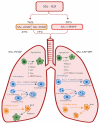The Role of Autophagy and Apoptosis in Affected Skin and Lungs in Patients with Systemic Sclerosis
- PMID: 37446389
- PMCID: PMC10342863
- DOI: 10.3390/ijms241311212
The Role of Autophagy and Apoptosis in Affected Skin and Lungs in Patients with Systemic Sclerosis
Abstract
Systemic sclerosis (SSc) is a complex autoimmune inflammatory disorder with multiple organ involvement. Skin changes present the hallmark of SSc and coincide with poor prognosis. Interstitial lung diseases (ILD) are the most widely reported complications in SSc patients and the primary cause of death. It has been proposed that the processes of autophagy and apoptosis could play a significant role in the pathogenesis and clinical course of different autoimmune diseases, and accordingly in SSc. In this manuscript, we review the current knowledge of autophagy and apoptosis processes in the skin and lungs of patients with SSc. Profiling of markers involved in these processes in skin cells can be useful to recognize the stage of fibrosis and can be used in the clinical stratification of patients. Furthermore, the knowledge of the molecular mechanisms underlying these processes enables the repurposing of already known drugs and the development of new biological therapeutics that aim to reverse fibrosis by promoting apoptosis and regulate autophagy in personalized treatment approach. In SSc-ILD patients, the molecular signature of the lung tissues of each patient could be a distinctive criterion in order to establish the correct lung pattern, which directly impacts the course and prognosis of the disease. In this case, resolving the role of tissue-specific markers, which could be detected in the circulation using sensitive molecular methods, would be an important step toward development of non-invasive diagnostic procedures that enable early and precise diagnosis and preventing the high mortality of this rare disease.
Keywords: SSc; SSc-ILD; apoptosis; autophagy; skin fibrosis.
Conflict of interest statement
The authors declare no conflict of interest.
Figures



Similar articles
-
Interstitial Lung Disease in Patients With Systemic Sclerosis: Toward Personalized-Medicine-Based Prediction and Drug Screening Models of Systemic Sclerosis-Related Interstitial Lung Disease (SSc-ILD).Front Immunol. 2020 Sep 4;11:1990. doi: 10.3389/fimmu.2020.01990. eCollection 2020. Front Immunol. 2020. PMID: 33013852 Free PMC article. Review.
-
Integrative analysis of lung molecular signatures reveals key drivers of systemic sclerosis-associated interstitial lung disease.Ann Rheum Dis. 2022 Jan;81(1):108-116. doi: 10.1136/annrheumdis-2021-220493. Epub 2021 Aug 11. Ann Rheum Dis. 2022. PMID: 34380701
-
The Molecular Mechanisms of Systemic Sclerosis-Associated Lung Fibrosis.Int J Mol Sci. 2023 Feb 3;24(3):2963. doi: 10.3390/ijms24032963. Int J Mol Sci. 2023. PMID: 36769282 Free PMC article. Review.
-
Current advances in the treatment of systemic sclerosis.Curr Opin Pharmacol. 2022 Jun;64:102211. doi: 10.1016/j.coph.2022.102211. Epub 2022 Apr 18. Curr Opin Pharmacol. 2022. PMID: 35447517 Free PMC article. Review.
-
[Use of pulmonary function tests and biomarkers studies to diagnose and follow-up interstitial lung disease in systemic sclerosis].Rev Pneumol Clin. 2014 Dec;70(6):335-42. doi: 10.1016/j.pneumo.2014.09.003. Epub 2014 Nov 20. Rev Pneumol Clin. 2014. PMID: 25457218 Review. French.
Cited by
-
Characterization of Endothelial Cell Subclusters in Localized Scleroderma Skin with Single-Cell RNA Sequencing Identifies NOTCH Signaling Pathway.Int J Mol Sci. 2024 Sep 28;25(19):10473. doi: 10.3390/ijms251910473. Int J Mol Sci. 2024. PMID: 39408800 Free PMC article.
References
Publication types
MeSH terms
Grants and funding
LinkOut - more resources
Full Text Sources
Medical

